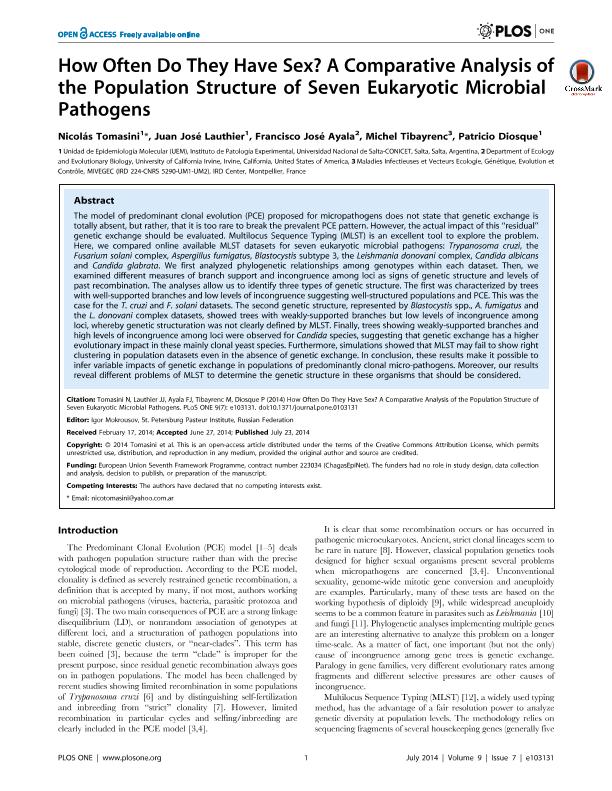Artículo
How often do they have sex? A comparative analysis of the population structure of seven eukaryotic microbial pathogens
Tomasini, Nicolás ; Lauthier, Juan José
; Lauthier, Juan José ; Ayala, Francisco Jose; Tibayrenc, Michel; Diosque, Patricio
; Ayala, Francisco Jose; Tibayrenc, Michel; Diosque, Patricio
 ; Lauthier, Juan José
; Lauthier, Juan José ; Ayala, Francisco Jose; Tibayrenc, Michel; Diosque, Patricio
; Ayala, Francisco Jose; Tibayrenc, Michel; Diosque, Patricio
Fecha de publicación:
23/07/2014
Editorial:
Public Library Of Science
Revista:
Plos One
ISSN:
1932-6203
Idioma:
Inglés
Tipo de recurso:
Artículo publicado
Clasificación temática:
Resumen
The model of predominant clonal evolution (PCE) proposed for micropathogens does not state that genetic exchange is totally absent, but rather, that it is too rare to break the prevalent PCE pattern. However, the actual impact of this "residual" genetic exchange should be evaluated. Multilocus Sequence Typing (MLST) is an excellent tool to explore the problem. Here, we compared online available MLST datasets for seven eukaryotic microbial pathogens: Trypanosoma cruzi, the Fusarium solani complex, Aspergillus fumigatus, Blastocystis subtype 3, the Leishmania donovani complex, Candida albicans and Candida glabrata. We first analyzed phylogenetic relationships among genotypes within each dataset. Then, we examined different measures of branch support and incongruence among loci as signs of genetic structure and levels of past recombination. The analyses allow us to identify three types of genetic structure. The first was characterized by trees with well-supported branches and low levels of incongruence suggesting well-structured populations and PCE. This was the case for the T. cruzi and F. solani datasets. The second genetic structure, represented by Blastocystis spp., A. fumigatus and the L. donovani complex datasets, showed trees with weakly-supported branches but low levels of incongruence among loci, whereby genetic structuration was not clearly defined by MLST. Finally, trees showing weakly-supported branches and high levels of incongruence among loci were observed for Candida species, suggesting that genetic exchange has a higher evolutionary impact in these mainly clonal yeast species. Furthermore, simulations showed that MLST may fail to show right clustering in population datasets even in the absence of genetic exchange. In conclusion, these results make it possible to infer variable impacts of genetic exchange in populations of predominantly clonal micro-pathogens. Moreover, our results reveal different problems of MLST to determine the genetic structure in these organisms that should be considered.
Archivos asociados
Licencia
Identificadores
Colecciones
Articulos(IPE)
Articulos de INST.DE PATOLOGIA EXPERIMENTAL
Articulos de INST.DE PATOLOGIA EXPERIMENTAL
Citación
Tomasini, Nicolás; Lauthier, Juan José; Ayala, Francisco Jose; Tibayrenc, Michel; Diosque, Patricio; How often do they have sex? A comparative analysis of the population structure of seven eukaryotic microbial pathogens; Public Library Of Science; Plos One; 9; 7; 23-7-2014; 103131-103131
Compartir
Altmétricas



